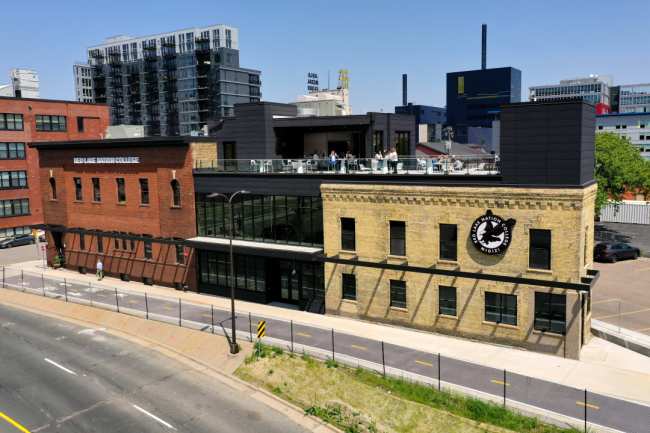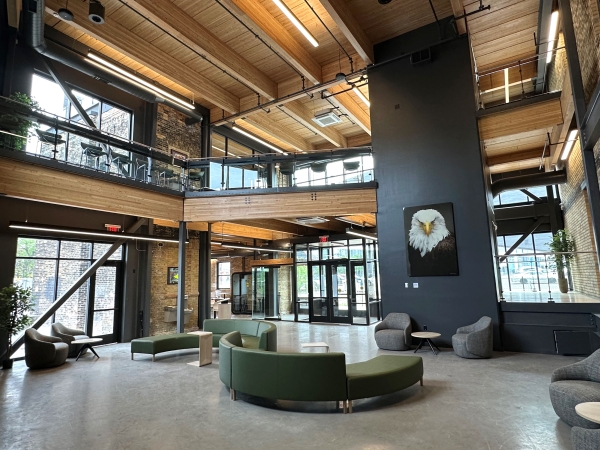You have /5 articles left.
Sign up for a free account or log in.

The Red Lake Nation College will open a new campus this fall, after an official ribbon cutting in June.
Red Lake Nation College
A new facility for students in the Minnesota’s Twin Cities region will further the reach of a local tribal college to educate Native students through an Indigenous lens.
This spring, Red Lake Nation College (RLNC) completed construction on a new three-building site, allowing the college to educate an additional 500 students in-person in downtown Minneapolis.
The facility is the first tribal college site in the Twin Cities, and campus leaders hope it expands the college’s ability to educate the local Native population, further connecting them to their culture and histories.
What’s the need: Just over one-quarter (26.5 percent) of Native American adults in the U.S. hold an associate degree or higher, according to a February report from the Lumina Foundation. Of the 58 percent of American Indian/Alaska Natives who enroll in higher education, 55 percent didn’t earn a credential.
Data from the National Student Clearinghouse Research Center found six-year completion rates fell 2 percentage points among Native Americans to 47.5 percent, 21 percentage points lower than their white peers and 27 percentage points lower than Asian students.
There are 37 tribal colleges and universities nationwide, founded on the principles of preserving and revitalizing Native languages and cultures. However, most of these campuses are focused in rural areas near reservations or tribal lands.
In Minnesota, 36.9 percent of the state’s American Indian population resides in the Twin Cities region, with 3,833 American Indian and Alaska Native people within Minneapolis alone, as of 2022 data.
“Minneapolis is home to one of the largest Native American populations in the country,” explains RLNC president Dan King. “The tribal college experience is necessary for students to connect to their culture and histories and learn from an Indigenous perspective.”
A project brief also detailed the low education achievement levels, large socioeconomic gaps and poverty rates of minority groups in Minnesota and nationally.
“This Native education project will be an attempt to close these education gaps and serve the ‘most underserved’ high-poverty community of Native Americans in the higher education field in Minnesota,” according to the sheet.
Building up: The facility can accommodate up to 500 learners in-person, but with online programs, up to 1,000 students, King says. RLNC had a total enrollment of 125 students in fall 2021, according to the Integrated Postsecondary Education Data System (IPEDS) data.

The new facility can accommodate up to 500 learners.
Red Lake Nation College
The building will be home to academic counseling, an innovation center, an art studio, a podcast room, mental health and wellness counseling, a food pantry and five faculty members, with an additional 16 professors teaching in a hy-flex distance education environment.
Better Identifying Native Learners
New federal guidelines around race and ethnicity will impact how states and institutions collect and report data on American Indian and Alaska Native populations, which researchers and policymakers hope will provide opportunities for improved analysis of these students.
The new site is just an expansion, not a new campus, meaning tuition and fees and academic programs do not differ between the two spaces, though students are enrolled at a specific location.
RLNC currently offers an Associate of Arts in liberal arts, an Associate of Applied Science in social and behavioral sciences, and a certificate in Ojibwe Language, all of which will be available to students at the Minneapolis site. The college has an open enrollment policy to any student with a high school diploma or GED and also provides non–degree seeking education to students and tribal elders.
Students who want to transfer after earning their degree can take advantage of the college’s articulation agreements with all public universities in the state and some private institutions, including Augsburg College, which offers free tuition for Native students.
What’s next: The new site is two train stops away from the American Indian Cultural Corridor in Minneapolis, where a majority of urban Native students come from, King explains. College leaders hope the closer proximity to students will expand access to a high-quality, culturally relevant education to the urban Native population.
The college also offers dual enrollment for local high school students, which will be a focus for future growth, as well as community extension outreach activities, workforce development programming and strong academics, King says.
Seeking stories from campus leaders, faculty members and staff for our Student Success focus. Share here.




